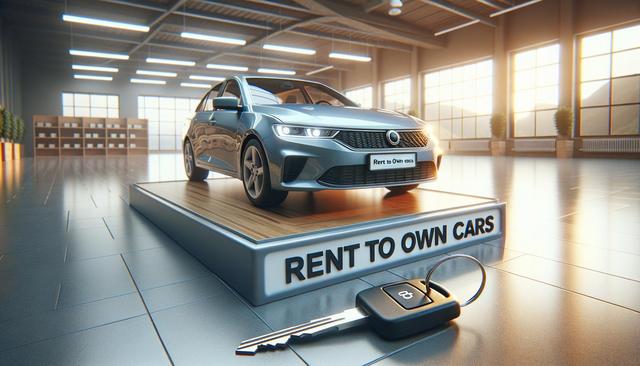Understanding Rent to Own Cars
Rent-to-own cars, also known as lease-to-own vehicles, offer a flexible route to car ownership for individuals who may not meet the criteria for traditional auto financing. This model allows you to rent a car with the option to purchase it at the end of the rental term. Unlike conventional loans, rent-to-own agreements often do not require a traditional credit check or significant upfront deposit, making them accessible to a broader range of drivers.
For many people, this method can be more approachable, especially for those rebuilding credit or without an established credit history. Typically, the rental period ranges from one to three years, during which part of the monthly payment may be applied toward the vehicle’s purchase price. As a result, you’re not just paying to use the car—you’re investing in ownership.
This approach is especially useful for those who need a car quickly but lack the financial resources for a large down payment. Additionally, rent-to-own agreements often include maintenance and service benefits, helping reduce the cost and responsibility associated with car upkeep.
Advantages of Renting a Car Through Lease-to-Own
Renting a car through a lease-to-own program offers several practical advantages. These benefits go beyond simply driving a vehicle and can be appealing for those looking for a stepping stone toward full ownership. Here are some of the notable advantages:
- Low or no credit check required
- Minimal upfront costs compared to traditional loans
- Monthly payments may count toward the purchase price
- Flexible contract terms
- Potential inclusion of maintenance and roadside support
These types of arrangements can be particularly helpful for people with inconsistent income or those who are self-employed, as they often do not rely on strict proof of income or high credit scores. Moreover, many providers allow for early buyout options, giving drivers the ability to own the vehicle sooner if their financial situation improves.
How to Get Started With a Lease-to-Own Car
Getting a car through a rent-to-own program is generally straightforward. The process begins with selecting a vehicle from a participating dealer or service provider. Once you’ve chosen a car, you’ll enter into a lease agreement that outlines the terms of your monthly payments, the length of the lease, and the option to purchase the car at the end of the term.
The steps typically include:
- Researching available rent-to-own programs in your area
- Selecting a vehicle that fits your needs and budget
- Reviewing and signing the lease agreement
- Making your monthly payments on time
- Exercising your purchase option at the end of the lease
Be sure to read the fine print before signing a contract. Understand any fees for early termination, late payments, or required maintenance responsibilities. Transparency during this stage is key to ensuring a smooth and successful path to car ownership.
Who Should Consider Rent-to-Own Options?
Lease-to-own cars are not for everyone, but they can be highly beneficial for specific groups of drivers. If you’re someone who does not qualify for traditional car loans due to a low credit score, lack of credit history, or inconsistent income, rent-to-own could be a viable alternative. This model also works well for individuals who:
- Need a car immediately but lack savings for a large deposit
- Are new to the country and have not yet established credit
- Prefer a flexible pathway to ownership
- Want to test out a vehicle before making a long-term commitment
Additionally, if you are in a transitional phase of life—such as relocating, changing jobs, or recovering from financial setbacks—rent-to-own options may offer the stability you need without locking you into rigid financing terms.
It’s important to evaluate your long-term budget and driving needs before entering into a lease-to-own agreement. While monthly payments may be higher than traditional leases, the added benefit of ownership at the end can be worthwhile for many drivers.
Points to Consider Before Signing a Lease-to-Own Agreement
Before committing to a rent-to-own vehicle, take time to consider a few critical factors. These agreements can work well under the right conditions, but they may not suit everyone. Key points to review include:
- Total cost of ownership over the lease term
- Vehicle condition and age at the time of agreement
- Included services such as maintenance or roadside assistance
- Penalties for missed or late payments
- Buyout terms at the end of the lease
It’s also advisable to compare rent-to-own programs with other alternatives, such as traditional rentals, certified pre-owned financing, or car-sharing services. Each option has unique benefits depending on your personal and financial circumstances.
Always request a full breakdown of costs and ensure that the vehicle has been inspected and documented for safety and performance. A well-informed decision will help you avoid unexpected issues and put you on the path to successful car ownership.
Conclusion: A Practical Path to Vehicle Ownership
Rent-to-own cars provide a practical and accessible way for many people to get behind the wheel without the barriers of traditional financing. Whether you’re working to rebuild your credit, need a car quickly, or simply want a more flexible path to ownership, lease-to-own options offer a valuable alternative worth considering. With careful planning, understanding of the contract terms, and consistent payments, you can eventually transition from renter to owner with confidence.







